The Economics and Statistics Division maintains archives of previous publications for accountability purposes, but makes no updates to keep these documents current with the latest data revisions from Statistics Canada. As a result, information in older documents may not be accurate. Please exercise caution when referring to older documents. For the latest information and historical data, please contact the individual listed to the right.
<--- Return to Archive
For additional information relating to this article, please contact:
October 08, 2021LABOUR MARKET TRENDS - SEPTEMBER 2021 Labour force survey results reflect the period from September 12 to 18. As of the reference week, several provinces had started or were planning to introduce vaccination proof requirements to enter non-essential venues, including restaurants, bars, and gyms. Indoor masking was re-introduced in some regions. The Canada-United States border reopened on August 9 for fully vaccinated Americans to enter without quarantine requirements and restrictions on global travellers were eased on September 7. Alberta re-introduced a curfew on serving alcohol and urged businesses to pause return-to-work plans. Nova Scotia postponed phase 5 reopening until October 4.
Nova Scotia’s seasonally adjusted employment level increased 1,400 (+0.3%) to 466,500 in September 2021 following on an increase in the three previous months as economy reopened after the third-wave lockdown period in spring 2021.
Nova Scotia’s employment was -0.1% (500) below the pre-COVID employment level of February 2020.
Nova Scotia’s labour force increased 2,600 (+0.5%) to 507,200 in September. The labour force in September was lower by 400 (-0.1%) than the February 2020 level while the population grew by 12,200 (+1.5%) over the same period. The number of unemployed persons increased 1,200 compared to August 2021 and was 100 higher compared to February 2020.
With a larger increase in labour force than employment, the unemployment rate increased 0.2 percentage points from last month to 8.0% in September 2021.

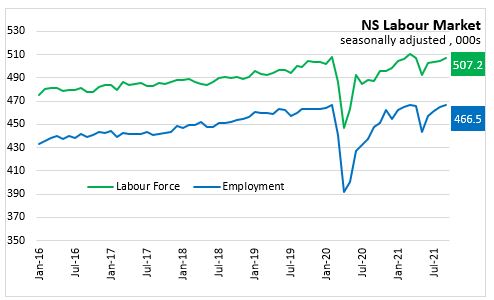
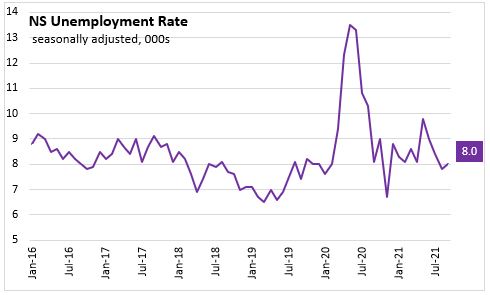

In September, full-time employment was up 1,300 (0.4%) to 372,500 position and part-time employment increased 200 (+0.2%) to 94,000. Compared to February 2020, full-time employment was lower by 3,600 (-1.0%) while part time employment was higher by 3,100 (+3.4%). (Note that this can include changes of hours within the same job.)
Nova Scotia’s participation rate was up 0.2 percentage points to 61.6% in September 2021. This was 0.9 percentage points below the February 2020 level. The number of persons not in the labour force decreased 900 (-0.3%) to 316,800 in September 2021, still elevated from levels seen prior to third-wave (March 2021) and pre-pandemic (February 2020).
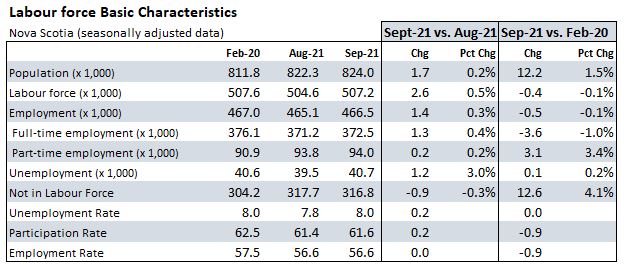
In addition to the employment decline from February 2020, there were elevated numbers of persons who are counted as employed, but have zero hours (for non-routine reasons like vacation, maternity/parental leave, labour dispute) or had their hours cut by 50% or more.
In September 2021 in Nova Scotia there were 23,800 persons employed but at less than 50% of their usual hours (including zero hours), down from 27,300 in August and lower than 45,900 in May 2021. Just before the third-wave lockdown (March 2021), there were an elevated number of people employed at fewer than usual hours at 27,700 persons. Pre-pandemic in February 2020 there were an estimated 19,800 persons with reduced hours.
Employment losses and substantially reduced hours combine to account for 1.0% of Nova Scotia’s February 2020 employment level. This is the lowest rate for Nova Scotia since start of the pandemic. The rate was 10.6% in May 2021 and 4.6% in June 2021 and peaked at 28.1% in April 2020. The largest total employment/hour impact in September 2021 was Prince Edward Island (4.2%). British Columbia rate is -0.1% with employment growth since February 2020 offsetting the additional employed people with reduced hours in the province.

Statistics Canada reported in supplemental information that from August to September 2021 Nova Scotia had a decrease of 3,800 in the number of people who were not in the labour force but wanted to work, currently at 14,300 people. The number of people not in labour force and wanting work is 1,000 more than February 2020.
The labour underutilization rate (COVID-19 impact definition) is the proportion of the potential labour force (labour force + those wanting work) that is either unemployed, not in labour force but wanted work or employed but have lost the majority of their usual hours.
In February 2020, Nova Scotia's labour underutilization rate was 14.1%. This underutilization increased to 37.1% in April 2020 and subsequently fell 15.5% in April 2021, before rising to 22.8% in May 2021 and declining 15.6% in August 2021. The labour underutilization rate of 15.1% in September 2021 is lowest since start of the pandemic.
Newfoundland and Labrador reported the highest labour underutilization in September 2021 at 23.7% and Quebec (11.9%) reported the lowest.
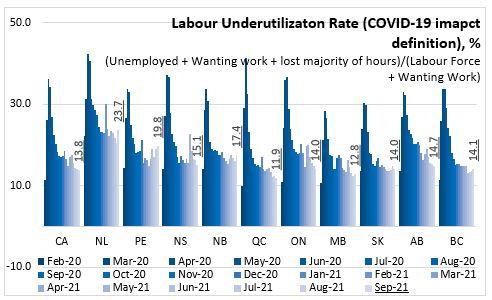
Age Cohorts
When compared to February 2020, youth (aged 15-24) and core aged workers (aged 25-54) saw lower employment levels in September 2021. In the youth cohort, employment declined 3,500 while the labour force was down 6,800. Employment among core-aged workers was down 3,300 along with a labour force decline of 2,800. For older workers (aged 55+), employment was up 6,400 while labour force was up 9,200; the population aged 55+ increased by 11,000 from February 2020 to September 2021.
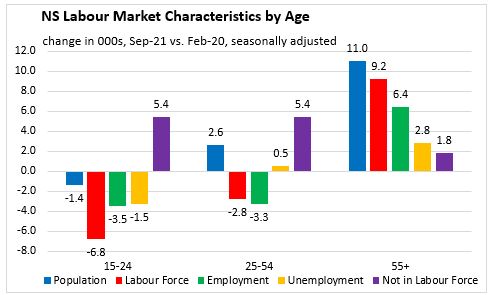
Compared to August 2021, unemployment rates decreased for youth and older workers but increased for core-aged workers. The youth unemployment rate declined 1.6 percentage points to 10.3% and the unemployment rate for older workers decreased 0.1 percentage points to 8.6%. For core-aged workers, the unemployment rate rose 0.7 percentage points to 7.2% in September 2021.
The participation rate for core-aged Nova Scotians rose by 1.4 percentage points to 86.6% in September. For younger workers, the participation rate declined by 1.0 percentage point to 67.6% and for older workers, the participation rate declined by 0.7 percentage points to 35.0%.
Compared to February 2020, the participation rate is down 5.4 percentage points for youth and 1.4 percentage points fore core-aged workers while rising 1.5 percentage points for older workers.
The employment rate was up for youth (+0.3 percentage points) and core-aged workers (+0.6 percentage points) in September 2021. The employment rate for older workers declined compared to the previous month (-0.6 percentage points).
Compared with February 2020, employment rates were down for youth (-2.4 percentage points), core-aged workers (-1.6 percentage points) while the employment rate was up for older workers (+0.8 percentage points).

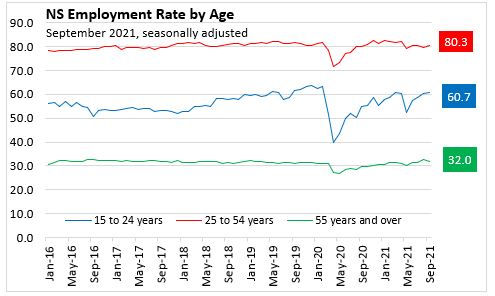

Males and Females
Compared to pre-pandemic levels seen in February 2020, female employment was slightly higher by 100 and male employment was down 600 in September 2021. Over the same period, female labour force rose 700 while male labour force was down 1,000. The number of unemployed females increased 500 while the number of males was down 400. The number of females not in the labour force was up 5,700 from February 2020 while the male population not in the labour force was up 6,900.
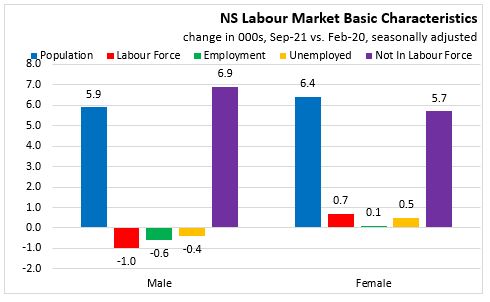
Female employment has reached pre-pandemic levels this month as part-time employment among females was higher (+7,800) than in February 2020. Female full-time employment is down 7,600 compared to February 2020. Male full-time employment was up 4,000 from pre-pandemic while males with part-time employment was down 4,600.

The September 2021 the participation rate rose 0.5 percentage points for female workers to 59.0% while it was unchanged for male workers at 64.4%.
The monthly employment rate was up 0.3 percentage points to 54.7% for females and was down 0.2 percentage points to 58.7% for males.
In September 2021, the monthly unemployment rate edged up 0.1 percentage points to 7.2% for female workers and increased 0.3 percentage points to 8.8% for male workers.

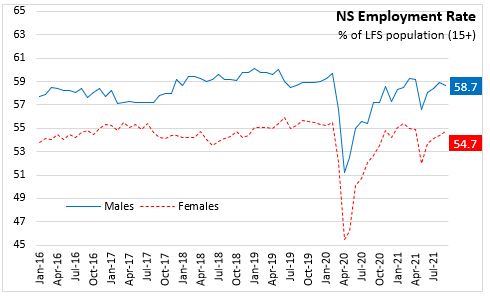

Sectors and Industries
The monthly employment increase in September consisted of gains in in public sector employees (+600) and private sector employees (+1,400), offset by a decline in self-employment of 600.
For September 2021, goods-producing sector employment was down 2,000 jobs compared with August 2021, with declines in resource sectors (-2,200) and construction (-1,700) offset by gains in utilities (+1,200) and manufacturing (+800).
Service-producing sector employment increased 3,500 in September. The largest employment gains for September occurred in wholesale/retail (+3,900), transportation/warehousing (+2,300) and accommodation and food services (+1,200). There were employment declines in in professional, scientific and technical services, health care and social assistance, and educational services in September 2021.
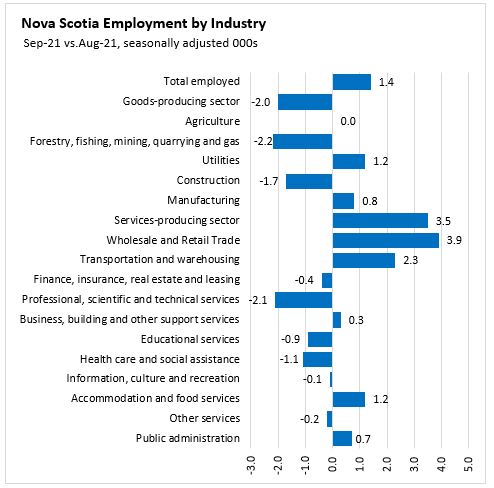
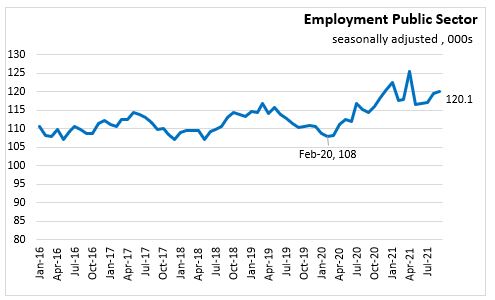
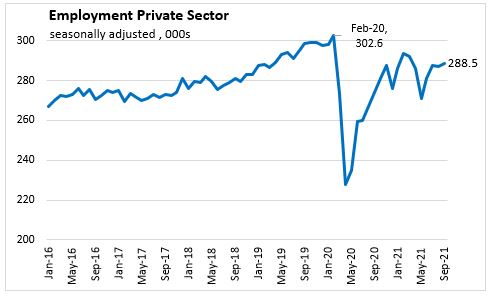
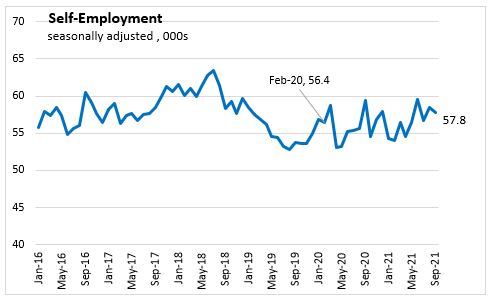
Comparing September 2021 with February 2020, employment was lower in the private sector (-14,100) while self-employment (+1,400) and public sector employment (+12,100) have increased.
Employment since February 2020 has declined 3,100 in goods-production industries with lower employment in manufacturing (-3,400), forestry, fishing, and mining (-1,300), and construction (-800). Utilities employment is 2,000 higher since February 2020.
For the first time since the start of the pandemic, Nova Scotia’s service-producing employment is up from the pre-pandemic threshold. Service industry employment in September 2021 was 2,600 higher than in February 2020. Employment gains from February 2020 through September 2021 have occurred professional, scientific and technical services (+7,400), transportation/warehousing (+6,100), health care and social assistance (+2,400), educational services (+2,000) and public administration (+1,900). Employment levels remains significantly lower in some sectors: accommodation and food services (-9,700), information, culture and recreation (-4,900), and wholesale/retail (-2,600). Other sectors are mostly unchanged.

Regions – September 2021 vs September 2020 (unadjusted 3 month moving average)
Regional results for September are three month moving averages from the period July-September. Changes do not reflect the full extent of employment volatility observed in monthly results for the province as a whole.
Compared with September 2020, Cape Breton employment increased by 1,600 (+3.1%) while labour force was up by 300 (+0.5%). The number of unemployed people decreased by 1,300 and the unemployment rate decreased by 2.2 percentage points to 11.5% in September 2021. The number of persons not in the labour force was down 1,100 compared to the same period one year ago.
For the North Shore region, the labour force increased 7,000 and employment was up 6,800. The number of unemployed people was up by 100 which resulted in a 0.7 percentage point decline in the unemployment rate to 7.7%. The number of persons not in the labour force declined by 7,000 compared to September 2020.
The Annapolis Valley reported an increase both in labour force (+4,600) and employment (+4,600) when compared to September 2020. The unemployment rate declined 0.8 percentage points to 8.5%. The number of persons not in the labour force declined 3,800 from a year earlier.
In the Southern region, labour force increased 1,900 while employment grew by 3,700 people when compared to September 2020. The number of unemployed was down 1,800 and the unemployment rate declined 3.7 percentage points to 7.7% in September 2021. The number of persons not in the labour force declined 1,900 from a year earlier.
In the Halifax region, the labour force posted an increase of 4,100 (+1.6%) while employment has increased 8,300 (+3.6%) compared to September 2020. The number of unemployed was down 4,200 and the unemployment rate fell to 6.8%. The number of persons not in the labour force increased by 3,200 in Halifax from a year ago.
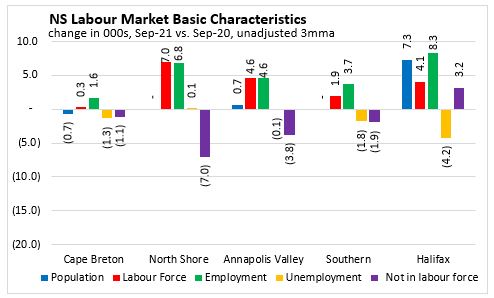
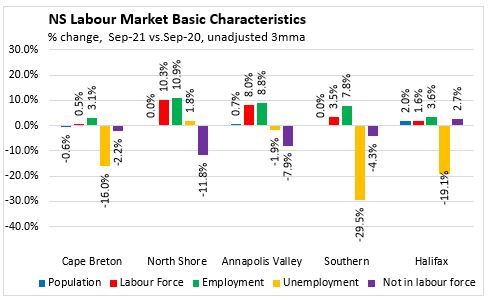
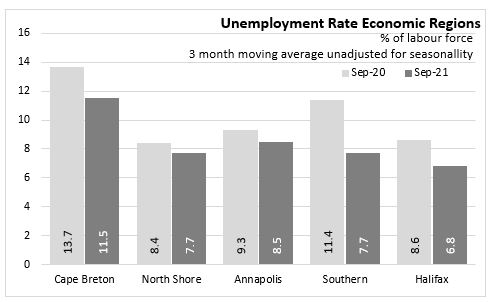
Provincial Comparisons
Employment increased month-over-month in nine provinces in September with only Newfoundland and Labrador (-0.4%) reporting a decline. The largest monthly employment gains were in New Brunswick (+1.7%) and Manitoba (+1.2%).
Nationally, employment was up 0.8% from last month in September 2021.
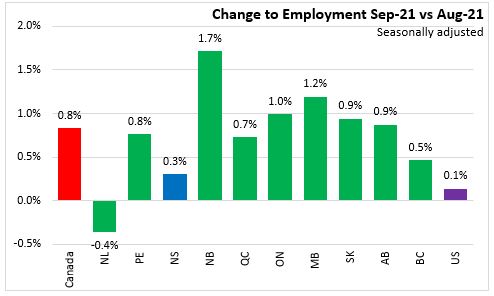
Compared to February 2020, the labour force has increased in six provinces. British Columbia (+2.4%) and Ontario (+2.1%) have seen the largest growth in labour force from pre-pandemic levels. The largest decline in the labour force since February 2020 to September 2021 was in Saskatchewan (-0.8%).
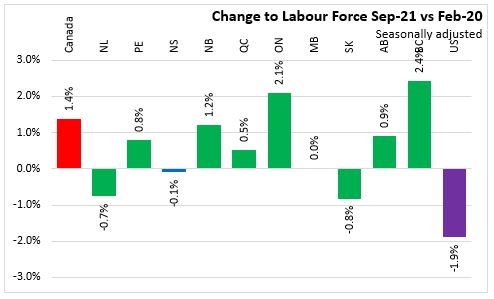
Employment is higher in British Columbia (+1.5%), Alberta (+0.2%) and Ontario (+0.1%) compared to pre-pandemic levels. Canada employment level was essentially unchanged (+0.0%) compared to February 2020. The largest employment declines since February 2020 were in Prince Edward Island (-2.7%) and Newfoundland and Labrador (-1.6%).
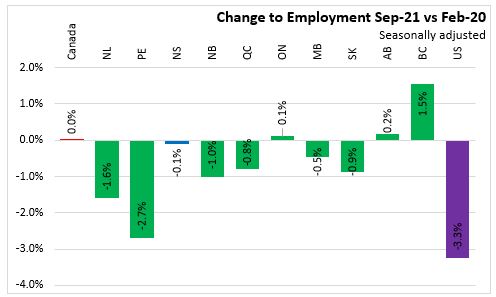
The highest unemployment rate for September 2021 was in Newfoundland and Labrador at 13.1% and the lowest rate was 5.6% in Manitoba. Canada’s unemployment rate was 6.9% in September 2021. Compared to February 2020, unemployment rates were higher in eight provinces and unchanged in Nova Scotia and Saskatchewan.
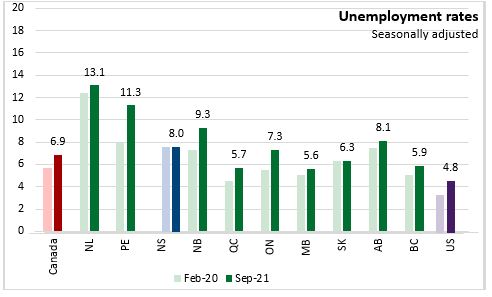
National Comparisons: Cities (Monthly, 3 month moving average)
The unemployment rate for Halifax Census Metropolitan Area (CMA) in September 2021 was 7.0% (seasonally adjusted 3 month moving average). Quebec City at 4.1% had the lowest unemployment rate among CMAs while the highest was in Windsor (10.4%).
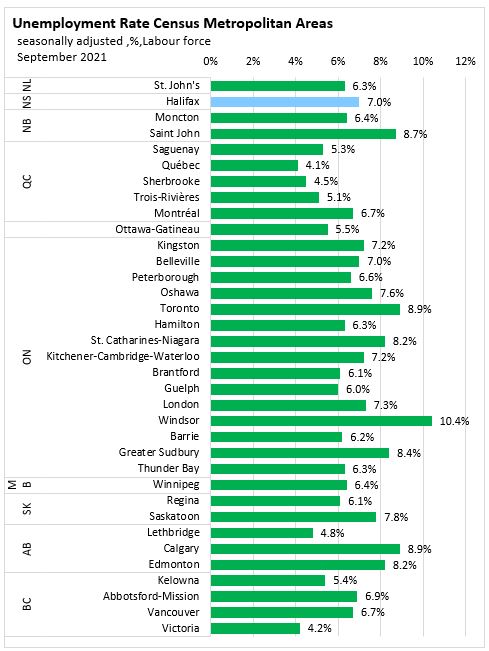
The seasonally adjusted employment rate for Halifax was 62.6%, up 0.5 percentage points compared to last month. Guelph (67.3%) had the highest employment rate while Belleville (52.4%) had the lowest among CMAs.
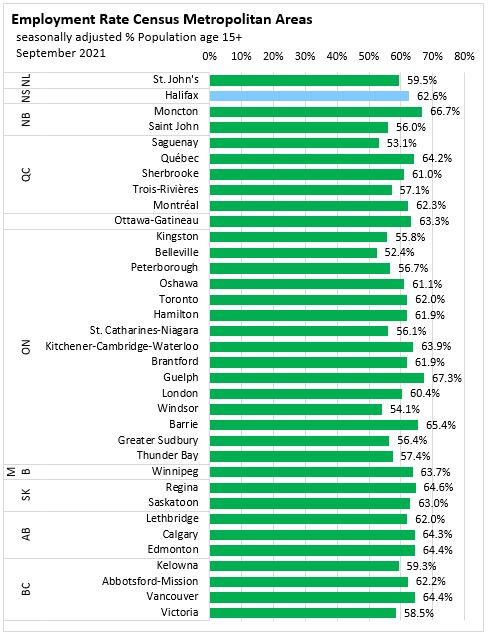
Halifax’s employment (3 month moving average) for September 2021 was up 1.1% compared to the August 2021 result. The employment level (Jul-Sep) average compared to previous average (Jun-Aug) was up by the largest amount in Belleville (+7.4%) and decreased the most in both Abbotsford-Mission and Victoria (-2.1%).

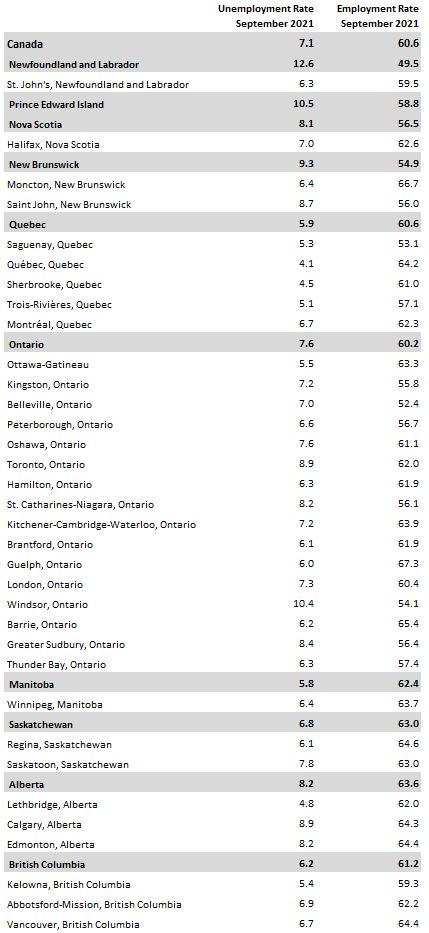
Note: Seasonally adjusted, 3 month average.
Sources:
Statistics Canada. Table 14-10-0287-01 Labour force characteristics, monthly, seasonally adjusted and trend-cycle, last 5 months
Statistics Canada. Table 14-10-0294-01 Labour force characteristics by census metropolitan area, three-month moving average, seasonally adjusted and unadjusted, last 5 months
Statistics Canada. Table 14-10-0293-01 Labour force characteristics by economic region, three-month moving average, unadjusted for seasonality, last 5 months
Statistics Canada. Table 14-10-0355-01 Employment by industry, monthly, seasonally adjusted and unadjusted, and trend-cycle, last 5 months (x 1,000)
Statistics Canada. Table 14-10-0288-01 Employment by class of worker, monthly, seasonally adjusted and unadjusted, last 5 months (x 1,000)
Statistics Canada. Table: 14-10-0380-02 Labour force characteristics, three month moving average, seasonally adjusted (x 1,000)
<--- Return to Archive